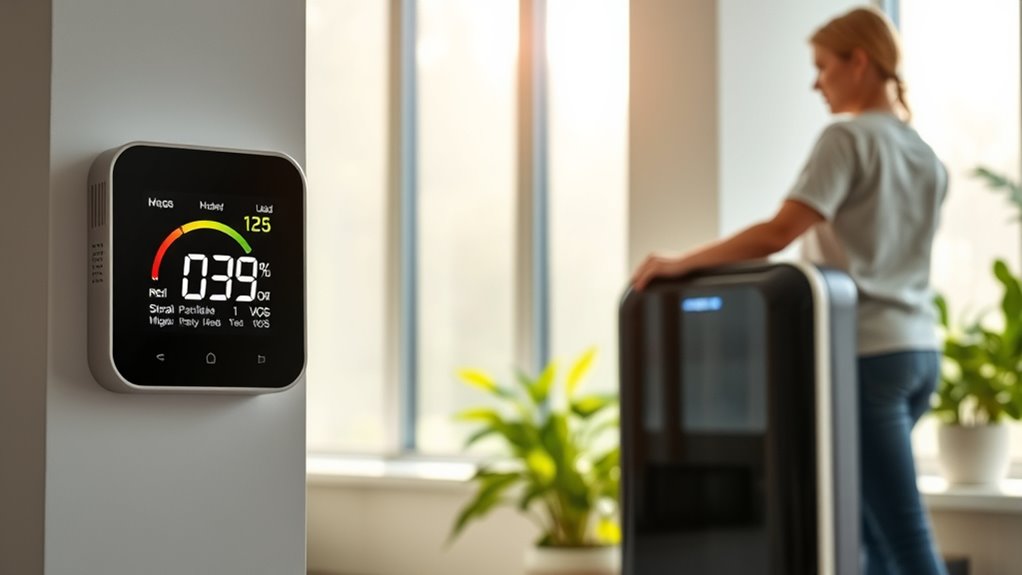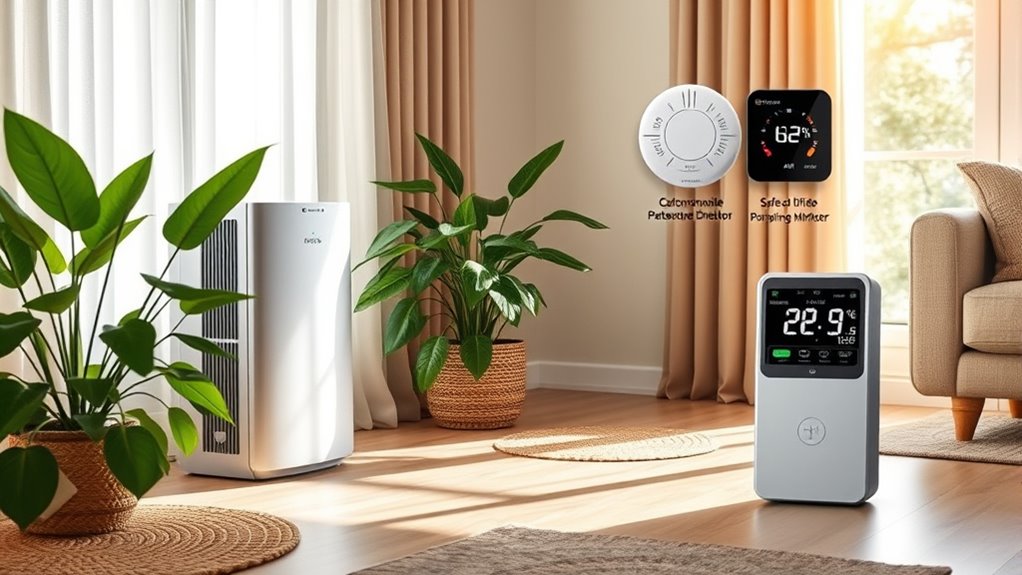To enhance indoor air quality, start by monitoring air levels with reliable sensors and maintain them regularly. Manage humidity by controlling moisture, fixing leaks, and using dehumidifiers and exhaust fans. Guarantee proper ventilation through window opening or ventilation systems. Minimize pollutants by choosing low-emission materials, testing for radon, and keeping your home clean. Maintain HVAC systems and filters properly. Incorporate indoor plants and air purifiers to naturally improve air. Keep exploring for detailed tips and strategies.
Key Takeaways
- Regularly monitor and calibrate indoor air quality sensors to ensure accurate pollutant measurements.
- Maintain proper humidity levels (30-50%) and control moisture to prevent mold growth.
- Ensure adequate ventilation through natural airflow and mechanical systems like exhaust fans or HVAC.
- Minimize indoor pollutants by choosing low-emission materials and reducing VOCs and mold sources.
- Perform routine HVAC maintenance, including filter replacement and system checks, for optimal indoor air quality.
Monitoring Indoor Air Quality Levels

Ever wondered how you can tell if your indoor air is safe to breathe? Monitoring indoor air quality levels is essential, and it starts with using reliable sensors. Proper sensor calibration guarantees accurate readings, so you’re not basing decisions on faulty data. Once calibrated, these sensors can continuously log data, providing a detailed record of air quality over time. Data logging helps identify patterns and pinpoint sources of pollutants, giving you a clear picture of your environment. Regularly checking and maintaining sensor calibration keeps your measurements precise. Calibration is a crucial step in ensuring that your readings remain trustworthy over time. By consistently tracking air quality data, you can take informed steps to improve your home’s indoor air, ensuring a healthier living space. Accurate monitoring is the foundation for creating a safe and comfortable indoor environment.
Managing Humidity and Moisture

After establishing how to monitor indoor air quality levels, managing humidity and moisture becomes the next key step in creating a healthy living environment. Proper control prevents mold growth and reduces allergens. Here are four essential tips:
Managing humidity and moisture is vital for a healthy home, preventing mold and reducing allergens effectively.
- Place your dehumidifier in damp areas like basements or bathrooms for effective moisture control.
- Keep indoor humidity levels between 30-50% to inhibit mold development.
- Fix leaks and water intrusion immediately to prevent moisture buildup.
- Use exhaust fans in kitchens and bathrooms to remove excess moisture.
- Be aware of family dynamics and cultural heritage that may influence household humidity levels and maintenance practices.
Ensuring Proper Ventilation and Air Exchange

Proper ventilation is essential for maintaining good indoor air quality because it helps remove indoor pollutants, excess moisture, and odors. To do this effectively, you need to monitor air exchange rates, guaranteeing fresh air circulates regularly. Installing the right ventilation systems, like exhaust fans or HVAC systems with proper airflow, keeps indoor air fresh and healthy. Regularly opening windows also boosts natural ventilation, especially in high-traffic areas. Keep in mind that inadequate ventilation can trap pollutants and humidity, worsening air quality. By maintaining ideal air exchange rates and using appropriate ventilation systems, you ensure a steady flow of clean, fresh air. This process helps reduce airborne contaminants, making your indoor environment healthier and more comfortable. Proper ventilation strategies can also help prevent issues related to high humidity levels, such as mold growth.
Minimizing Indoor Pollutants and Toxins

To effectively minimize indoor pollutants and toxins, you need to identify common sources and take targeted actions to reduce exposure. First, test for radon and consider radon mitigation measures to prevent dangerous buildup. Second, implement VOC reduction strategies by reducing use of strong-smelling products, storing chemicals properly, and increasing ventilation. Third, control mold growth by fixing leaks and keeping humidity levels low. Fourth, keep your home clean and dust-free, as dust can carry allergens and toxins. Additionally, maintaining proper air filtration can significantly enhance air quality. By focusing on radon mitigation and VOC reduction strategies, you can profoundly improve your indoor air quality. Regular maintenance and awareness help ensure harmful pollutants stay at bay, creating a safer, healthier environment for you and your family.
Selecting Low-Emission Building Materials and Products

Choosing building materials and products with low emissions is a key step in maintaining healthy indoor air quality. Opt for sustainable materials that prioritize low chemical emissions, helping reduce indoor pollutants. Look for products labeled as low-VOC or zero-VOC, as these indicate fewer volatile organic compounds that can off-gas over time. When selecting flooring, cabinetry, paints, and adhesives, prioritize options that are certified for indoor air quality standards. Avoid materials with formaldehyde or other hazardous chemicals, as these can substantially impact air quality and occupant health. By making mindful choices, you minimize chemical emissions and create a healthier indoor environment. Your focus on low-VOC materials supports both your well-being and environmental sustainability.
Regular Cleaning and Dust Control

How often do you think about the dust and allergens lurking in your home? Regular cleaning is essential for reducing dust buildup and improving indoor air quality. Here’s what you should focus on:
Thinking about dust and allergens? Regular cleaning is key to healthier indoor air and a cleaner home.
- Dust surfaces weekly with a damp cloth to trap allergens effectively.
- Vacuum carpets and rugs at least twice a week using a HEPA filter to prevent dust from spreading.
- Wash bedding and curtains regularly to reduce dust mites and allergens.
- Mop hard floors weekly to remove settled dust and debris.
- Consider upgrading your air filtration systems or using air purifiers to further reduce airborne pollutants.
Consistent cleaning cuts down on dust buildup, helping you breathe easier and lowering allergen levels. Keeping dust and allergens in check isn’t just about cleanliness—it’s a vital step toward healthier indoor air.
Utilizing Air Purifiers and Filtration Systems

After you’ve established a regular cleaning routine, adding air purifiers and filtration systems can further improve your indoor air quality. Proper air purifier placement is key; position units in high-traffic areas or rooms with poor ventilation to maximize effectiveness. When choosing filtration system types, consider HEPA filters for capturing airborne particles like dust, pollen, and pet dander, and activated carbon filters for odors and chemicals. Ensure your purifier’s size matches your room’s square footage for ideal performance. Regularly replace filters as recommended by the manufacturer to maintain efficiency. Additionally, understanding air quality and monitoring it can help you determine when to use your purifier more intensively. Combining strategic placement with suitable filtration system types helps reduce pollutants, creating a healthier environment indoors. This proactive step greatly lowers airborne contaminants, supporting better respiratory health and overall comfort in your home.
Incorporating Indoor Plants for Natural Purification

Incorporating indoor plants into your home not only adds aesthetic appeal but also naturally improves air quality. When selecting plants, focus on those known for air-purifying properties, like snake plants or pothos. Proper plant selection is key to maximizing benefits. Pay attention to soil health by using well-draining soil, which prevents root rot and promotes healthy growth. Here are four tips to optimize your indoor greenery: 1. Choose plants suited for low-light conditions. 2. Regularly water, but avoid overwatering to protect soil health. 3. Use organic soil mixes to support healthy root systems. 4. Rotate plants periodically for even growth and air purification. Additionally, understanding the importance of soil health can lead to more sustainable and effective plant care.
Maintaining HVAC Systems for Optimal Performance

To keep your HVAC system running efficiently, it’s essential to stick to a regular maintenance schedule. Replacing filters on time can improve air quality and save energy. By staying proactive, you guarantee your system performs at its best all year round. Incorporating air purification techniques with your regular maintenance can further enhance indoor air quality.
Regular Maintenance Schedule
Regular maintenance is crucial to keep your HVAC system running efficiently and guarantee good indoor air quality. Scheduling routine checks helps you identify issues early, especially with air quality sensors that monitor pollutants. A well-maintained system minimizes pollutant sources and ensures proper airflow. To stay on top of maintenance, consider these steps:
- Inspect and clean air quality sensors regularly for accurate readings.
- Check for and seal any leaks or drafts around ducts and vents.
- Schedule professional tune-ups to optimize system performance.
- Clear debris from outdoor units to prevent blockages and improve airflow.
- Keep an eye on sensor calibration to ensure your air quality readings remain accurate.
Staying consistent with these tasks helps reduce pollutants and maintains a healthy indoor environment, supporting better air quality over time.
Filter Replacement Tips
Keeping your HVAC system in top shape depends heavily on timely filter replacements. Different air filter types, like fiberglass, pleated, or electrostatic filters, require varying replacement schedules. Check the manufacturer’s recommendations for your specific filter, but generally, filters should be replaced every 30 to 90 days. Factors such as pet dander, allergies, or high indoor pollution may increase the frequency needed. Regularly inspecting your filters helps you determine when it’s time for a change, ensuring ideal airflow and indoor air quality. Avoid delaying replacements, as clogged filters reduce system efficiency and can lead to poor air circulation. Staying on top of filter replacement frequency is also essential for managing air quality, which can influence health and comfort. By staying on top of filter replacement frequency, you’ll improve your indoor environment and extend the lifespan of your HVAC system.
Frequently Asked Questions
How Do I Identify Hidden Sources of Indoor Air Pollution?
To identify hidden sources of indoor air pollution, you should inspect for hidden contaminants like mold, dust, or chemical residues behind walls, under carpets, and inside ventilation systems. Use air quality monitors to detect pollutants and regularly check your HVAC and ventilation solutions for mold or debris buildup. Improving ventilation helps reduce these hidden contaminants, ensuring cleaner indoor air and a healthier environment.
What Are the Signs of Poor Indoor Air Quality?
You might notice persistent allergies, coughing, or unexplained headaches, all signs of poor indoor air quality. Inadequate ventilation strategies can cause stale air and high levels of airborne allergens like dust or pet dander. If you feel stuffy or notice a musty odor, it’s a clear indicator that you need to improve airflow and reduce airborne allergens. Regularly checking ventilation and cleaning can markedly enhance your indoor air quality.
How Often Should Indoor Air Quality Be Tested?
Did you know that indoor air can be up to five times more polluted than outdoor air? You should test your indoor air quality at least once a year, especially if you use various ventilation strategies or have pets. Regular testing helps identify issues early. Consider different air purifier types—HEPA, activated carbon, or UV models—to improve air quality. Testing guarantees your home’s air remains fresh and healthy year-round.
Can Indoor Plants Actually Improve Air Quality Effectively?
Indoor plants can improve air quality effectively through natural air purification, but their impact varies based on plant selection. Opt for plants like snake plants, pothos, or peace lilies, which are known for filtering toxins and increasing humidity. While they help, don’t rely solely on them. Combine plant selection with good ventilation and regular cleaning to truly enhance your indoor air quality.
What Are Cost-Effective Ways to Improve Indoor Air Quality?
Think of your home’s air as a garden needing regular tending. To enhance indoor air quality affordably, invest in air purifiers with HEPA filters and guarantee proper ventilation systems are working efficiently. Regularly open windows to renew the air and reduce pollutants. These simple, cost-effective steps act like a gust of fresh air, transforming your space into a healthier sanctuary without breaking the bank.
Conclusion
By following this checklist, you’ll create an indoor environment as fresh and clean as a spring breeze. Regularly monitor air quality, manage humidity, and keep your space well-ventilated. Minimize pollutants, choose low-emission products, and stay on top of cleaning and filter maintenance. Incorporate plants naturally to purify the air, making your home a sanctuary. Think of your efforts as tending a garden—consistent care will guarantee your indoor air stays healthy and invigorating.










